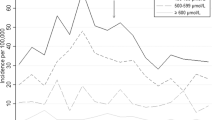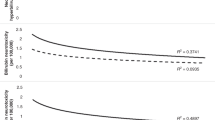Abstract
Objective:
To describe and compare infants with severe hyperbilirubinemia, who presented with and without abnormal neurological findings and to identify associated risk factors.
Study Design:
Data on infants with severe hyperbilirubinemia (>425 μmol l−1 and/or received exchange transfusion) were collected prospectively through the Canadian Paediatric Surveillance Program (CPSP) from 2002 to 2004. Cases were categorized into two groups on the basis of information provided by the reporting physician: neurologically normal or abnormal. Demographic characteristics were compared and univariate logistic regression was performed to identify factors associated with acute neurological abnormalities in infants.
Result:
Of the initial cohort of 258 infants, 32 (12.4%) were identified to have neurological abnormalities. Infants in the highest peak bilirubin level group (>550 μmol l−1) had the greatest risk of acute neurological abnormalities. The mid range (451 to 550 μmol l−1) and lowest level (⩽450 μmol l−1) groups were less likely to have abnormalities (odds ratio (OR)=0.174; P=0.0013 and 0.402; P=0.0613, respectively). Exchange transfusion and presentation within the first 2 days of age were positively associated with abnormal neurological findings in infants (OR=3.332, P=0.003 and OR=2.572, P<0.0001, respectively).
Conclusion:
In this national cohort of infants with severe hyperbilirubinemia, a significant percentage of infants developed acute bilirubin encephalopathy. Long-term neurodevelopmental follow-up is necessary to determine the incidence of permanent neurological sequelae.
This is a preview of subscription content, access via your institution
Access options
Subscribe to this journal
Receive 12 print issues and online access
$259.00 per year
only $21.58 per issue
Buy this article
- Purchase on Springer Link
- Instant access to full article PDF
Prices may be subject to local taxes which are calculated during checkout
Similar content being viewed by others
References
Tan-Dy C, Moore A, Satodia P, Blaser S, Fallagh S . Predicting kernicterus in severe unconjugated hyperbilirubinemia. Paediatr Child Health 2004; 9 (Suppl A): 17A.
Lee KS, Perlman M . The impact of early obstetric discharge on newborn health care. Curr Opin Pediatr 1996; 8 (2): 96–101.
Lee KS, Perlman M, Ballantyne M, Elliott I, To T . Association between duration of neonatal hospital stay and readmission rate. J Pediatr 1995; 127 (5): 758–766.
Liu S, Wen SW, McMillan D, Trouton K, Fowler D, McCourt C . Increased neonatal readmission rate associated with decreased length of hospital stay at birth in Canada. Can J Public Health 2000; 91 (1): 46–50.
Brown AK, Damus K, Kim MH, King K, Harper R, Campbell D et al. Factors relating to readmission of term and near term neonates in the first two weeks of life. J Perinat Med 1999; 27 (4): 263–275.
Bhutani VK, Johnson LH . Urgent clinical need for accurate and precise bilirubin measurements in the United States to prevent kernicterus. Clin Chem 2004; 50 (3): 477–480.
Bhutani VK, Johnson LH, Keren R . Diagnosis and management of hyperbilirubinemia in the term neonate: for a safer first week. Pediatr Clin North Am 2004; 51: 843–861.
Bhutani VK, Johnson L, Sivieri EM . Predictive ability of a predischarge hour-specific serum bilirubin for subsequent significant hyperbilirubinemia in healthy term and near-term newborns. Pediatrics 1999; 103 (1): 6–14.
Johnson LH, Bhutani VK, Brown AK . System-based approach to management of neonatal jaundice and prevention of kernicterus. J Pediatr 2002; 140 (4): 396–403.
Sgro M, Campbell D, Shah V . Incidence and causes of severe neonatal hyperbilirubinemia in Canada. CMAJ 2006; 175 (6): 587–590.
AlOtaibi SF, Blaser S, MacGregor DL . Neurological complications of kernicterus. Can J Neurol Sci 2005; 32 (3): 311–315.
American Academy of Pediatrics Clinical practice guideline. Management of hyperbilirubinemia in the newborn infant 35 or more weeks of gestation. Pediatrics 2004; 114 (1): 297–316.
Maisels MJ, Newman TB . Kernicterus in otherwise healthy, breast-fed term newborns. Pediatrics 1995; 96 (4): 730–733.
Penn AA, Enzmann DR, Hahn JS, Stevenson DK . Kernicterus in a full term infant. Pediatrics 1994; 93 (6): 1003–1006.
Johnson L, Bhutani VK . Guidelines for management of the jaundiced term and near term infant. Clin Perinatol 1998; 25 (3): 555–574.
Manning D, Todd P, Maxwell M, Jane Platt M . Prospective surveillance study of severe hyperbilirubinaemia in newborn in the UK and Ireland. Arch Dis Child Fetal Neonatal Ed 2007; 92 (5): 341–346.
Harris MC, Bernbaum JC, Polin JR, Zimmerman R, Polin RA . Developmental follow-up of breastfed term and near-term infants with marked hyperbilirubinemia. Pediatrics 2001; 107 (5): 1075–1080.
Newman TB, Maisels MJ . Less aggressive treatment of neonatal jaundice and reports of kernicterus: lessons about practice guidelines. Pediatrics 2000; 105 (1 part 3): 242–245.
Dennery PA, Seidman DS, Stevenson DK . Neonatal hyperbilirubinemia. N Engl J Med 2001; 344 (8): 581–590.
Brown AK, Johnson L . Loss of concern about jaundice and the re-emergence of kernicterus in full-term infants in an era of managed care. In: Fanarof A, Klaus M (eds). The Year Book of Neonatal and Perinatal Medicine. Mosby Year Book: St Louis, MO, 1996, pp 17–28.
Johnson L, Brown AK, Bhutani VK . BIND-A clinical score for bilirubin induced neurologic dysfunction in newborns. Pediatr Suppl 1999; 104: 746.
Canadian Paediatric Society. Guidelines for detection, management and prevention of hyperbilirubinemia in term and late preterm newborn infants (35 or more weeks’ gestation). Paediatr Child Health 2007; 12 (5): 401–407.
Johnson L, Bhutani VK, Karp K, Sivieri EM, Shapiro SM . Clinical report from the pilot USA Kerniterus Registry (1992 to 2004). J Perinatol 2009; 29 (Suppl 1): S25–S45.
American Academy of Pediatrics, Provisional Committee for Quality Improvement and Subcommittee on Hyperbilirubinemia. Practice parameter: management of hyperbilirubinemia in the healthy term newborn. Pediatrics 1994; 94 (4): 558–565.
Statistics Canada. Canadian Statistics. Birth rate 2004 to 2005 http://www40.statcan.gc.ca/l01/cst01/demo02a-eng.htmAccessed 11 November, 2009.
Bjerre JV, Petersen JR, Ebbesen F . Surveillance of extreme hyperbilrubinaemia in Denmark. A method to identify the newborn infants. Acta Paediatr 2008; 97 (8): 1030–1034.
Ebbesen F, Andersson C, Verder H, Grytter C, Pedersen-Bjergaard L, Petersen JR et al. Extreme hyperbilirubinemia in term and near-term infants in Denmark. Acta Paediatr 2005; 94 (1): 59–64.
Johnson LH, Bhutani VK, Brown AK . System-based approach to management of neonatal jaundice and prevention of kernicterus. J Pediatr 2002; 140 (4): 396–403.
Acknowledgements
Supported in part by a Grant from the Ontario Federation for Cerebral Palsy. We thank Dr Danielle Grenier and the Canadian Pediatric Surveillance Program (CPSP) for their support of this research.
Author information
Authors and Affiliations
Corresponding author
Ethics declarations
Competing interests
The authors declare no conflict of interest.
Rights and permissions
About this article
Cite this article
Sgro, M., Campbell, D., Barozzino, T. et al. Acute neurological findings in a national cohort of neonates with severe neonatal hyperbilirubinemia. J Perinatol 31, 392–396 (2011). https://doi.org/10.1038/jp.2010.137
Received:
Revised:
Accepted:
Published:
Issue Date:
DOI: https://doi.org/10.1038/jp.2010.137
Keywords
This article is cited by
-
Can bilirubin/albumin ratio predict neurodevelopmental outcome in severe neonatal hyperbilirubinemia? A 3-month follow up study
Egyptian Pediatric Association Gazette (2021)
-
Extreme neonatal hyperbilirubinemia and kernicterus spectrum disorder in Denmark during the years 2000–2015
Journal of Perinatology (2020)
-
Neurodevelopment after moderate hyperbilirubinemia at term
Pediatric Research (2013)
-
Should we screen newborns for glucose-6-phosphate dehydrogenase deficiency in the United States?
Journal of Perinatology (2013)
-
Neonatal hyperbilirubinemia and Rhesus disease of the newborn: incidence and impairment estimates for 2010 at regional and global levels
Pediatric Research (2013)



